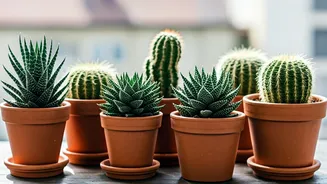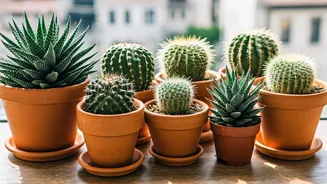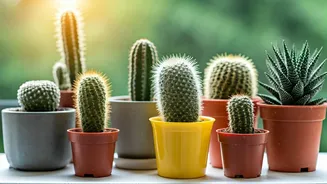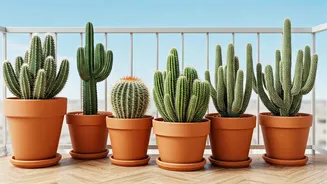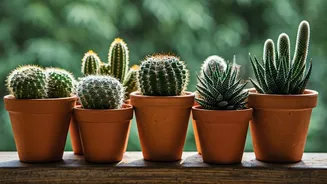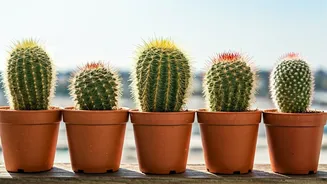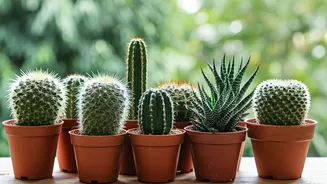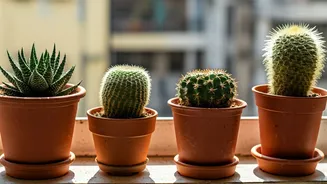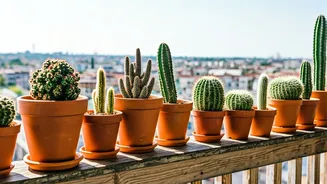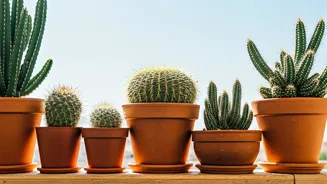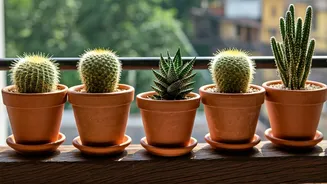Introduction to Cactus
Cacti, known for their resilience and striking forms, are ideal for adding visual interest to indoor spaces. They are relatively low-maintenance, perfect
for those with busy schedules or limited gardening experience. The appeal of these desert dwellers lies in their adaptability, allowing them to flourish in various environments. With the correct care, these cacti can thrive on a balcony, transforming it into a personal oasis. This article highlights seven specific varieties suited for such a setting, providing detailed information to guide both novice and experienced gardeners. It stresses the importance of understanding the specific needs of each type for optimal growth and aesthetic appeal, making balcony gardening accessible and rewarding.
The Old Lady Cactus
The Old Lady Cactus, or Mammillaria hahniana, is a globular cactus covered in soft, white hairs, creating a visually appealing texture. It is a slow-growing plant, making it a suitable choice for smaller spaces. The Old Lady Cactus is relatively easy to care for; it requires bright, indirect light and well-draining soil. Watering should be infrequent, allowing the soil to dry out completely between waterings to prevent root rot. During the growing season, a light feeding with a cactus-specific fertilizer can promote healthy growth. The Old Lady Cactus produces small, pinkish-purple flowers, adding a touch of color to the plant. This cactus's unique appearance and easy care make it a great option for beginners.
Star Cactus Wonders
The Astrophytum asterias, also known as the Star Cactus, is recognizable by its flat, star-shaped body. The Star Cactus is a popular choice for indoor gardening because of its unique shape and relatively low maintenance needs. It requires bright, direct sunlight, so placing it in a location where it can receive several hours of sunlight daily is essential. Well-draining soil is crucial to prevent rot. Watering should be done sparingly, allowing the soil to dry out between waterings. Fertilizing during the growing season can encourage robust growth. The Star Cactus often produces beautiful, yellow flowers, adding an aesthetic appeal to the plant. Its unique appearance and ease of care make the Star Cactus a favorite among cactus enthusiasts.
Bunny Ear Delight
The Opuntia microdasys, or Bunny Ears Cactus, is a charming cactus characterized by its flat, rounded pads that resemble bunny ears. This cactus adds a playful element to any indoor garden. The Bunny Ears Cactus needs bright light and well-draining soil to thrive. While it can tolerate direct sunlight, it should be gradually introduced to prevent sunburn. Watering should be infrequent, especially during the dormant season. The Bunny Ears Cactus is sensitive to overwatering, so it's essential to allow the soil to dry out between waterings. This cactus is also known for its small glochids, tiny barbed bristles that can cause skin irritation; careful handling is advised. The Bunny Ears Cactus's distinctive appearance makes it a fun addition to any balcony garden.
Moon Cactus Magic
The Gymnocalycium mihanovichii, commonly known as Moon Cactus, stands out due to its colorful top grafted onto a Hylocereus stock. The Moon Cactus adds a vibrant pop of color to any space. The colored top of the Moon Cactus doesn't have chlorophyll, so it depends on the Hylocereus rootstock for survival. These cacti need bright, indirect light; direct sunlight can scorch the colorful top. Watering should be done sparingly, and the soil must be well-draining. The Moon Cactus is a striking addition to a balcony garden because of its unusual appearance. The diverse color variations offer a unique way to introduce visual appeal to any collection. Proper care ensures the vibrant top of the cactus remains healthy and visually stunning.
Saguaro's Tiny Cousin
The Saguaro Cactus (Carnegiea gigantea) is a well-known species, but the miniature versions, appropriate for indoor balconies, are equally stunning. These slow-growing cacti symbolize the vast deserts. Miniature Saguaros demand bright, direct sunlight, thriving best when exposed to several hours of sun daily. Well-draining soil is vital to prevent root rot, and watering should be infrequent, allowing the soil to dry out completely before rewatering. Fertilizing is not a necessity but can support healthy growth during the growing season. The miniature Saguaro, with its iconic shape and minimal needs, brings a touch of the American Southwest to any balcony, creating a captivating display. Their resilience and slow growth make them ideal for balcony gardens.
Chin Cactus Charm
The Gymnocalycium, often called Chin Cactus, is known for its distinctive ribbed appearance. These cacti come in many shapes and sizes. Chin Cacti require bright, indirect light, and prefer well-draining soil to prevent rot. Watering should be done sparingly, only when the soil is completely dry. Some varieties produce colorful flowers, enhancing their aesthetic appeal. The Chin Cactus provides variety in texture and shape. Proper care involves understanding its watering needs and light requirements. These cacti are durable and easy to maintain, making them a great choice for both novice and experienced gardeners looking to create an attractive balcony display. With diverse forms and easy care, the Chin Cactus provides a rewarding gardening experience.
